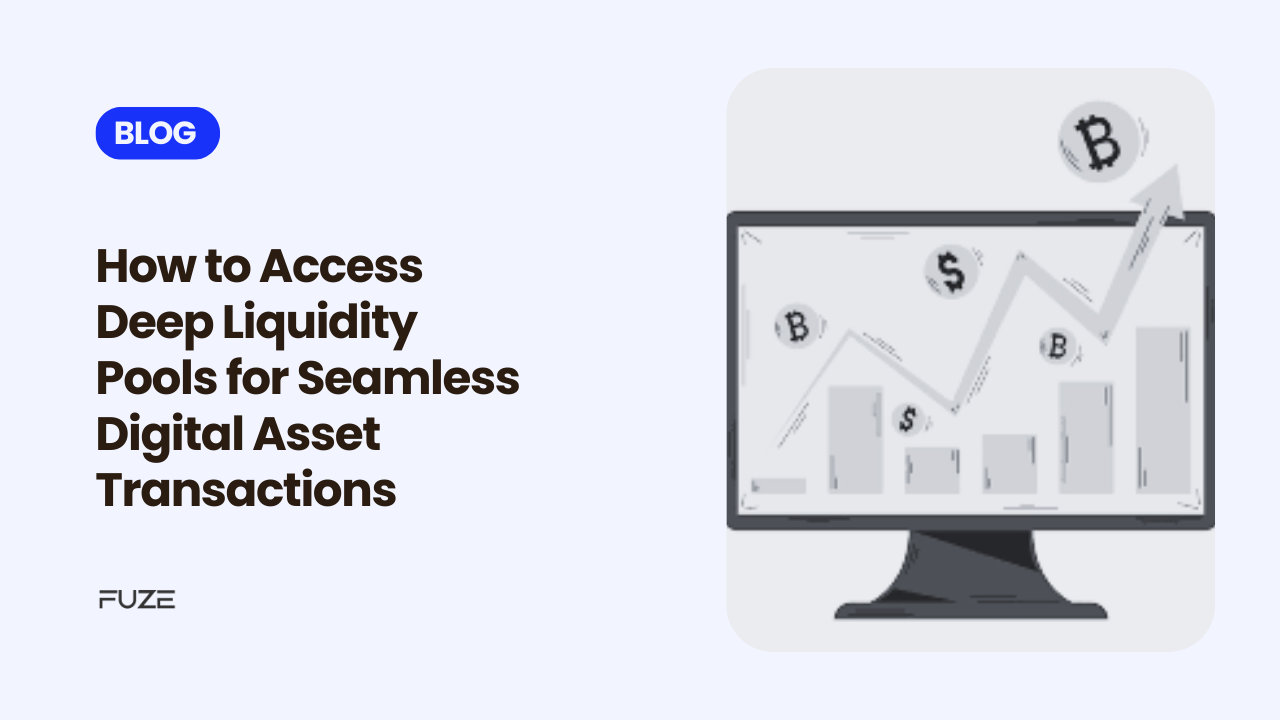As the digital asset market continues to grow and evolve, liquidity has become a cornerstone for seamless trading and transaction execution. Deep liquidity pools ensure that trades can occur quickly, efficiently, and with minimal price impact, making them essential for institutional investors, traders, and businesses alike.
In this blog, we will explore what liquidity pools are, why deep liquidity matters, and how you can access them to enhance your digital asset transactions.
What Are Liquidity Pools?
Liquidity pools are a collection of funds that are secured in smart contracts to support trading on decentralised platforms. They are essential for decentralised exchanges (DEXs), allowing users to trade digital assets without relying on a conventional order book system. Unlike centralised exchanges that depend on market makers for liquidity, liquidity pools utilise automated market makers (AMMs). These algorithms set asset prices based on the proportion of tokens in the pool. Typical examples of liquidity pools can be found on decentralised platforms and lending protocols.
Why Is Deep Liquidity Important?
Deep liquidity means having a large volume of assets in a market or pool, which allows for significant transactions to take place without causing major price changes. Here’s why deep liquidity matters:
- Reduced Slippage: With deep liquidity, slippage is minimised, ensuring that the price at which a trade is executed stays close to the expected price, even for larger orders.
- Efficient Trading: High liquidity results in quicker transaction execution, which reduces delays and enhances the overall trading experience.
- Lower Costs: Deep liquidity narrows the spread between bid and ask prices, making transactions more affordable.
- Market Stability: A liquid market is less vulnerable to manipulation and extreme price swings, which helps build greater trust among participants.
Key Steps to Access Deep Liquidity Pools
- Choose the Right Platform
The first step in accessing deep liquidity pools is to select a platform that suits your needs. Both centralised exchanges (CEXs) and decentralised exchanges (DEXs) provide liquidity pools, but they each come with unique benefits:
Centralised Exchanges: These platforms gather liquidity from a wide user base, resulting in deep order books and quick execution. Centralised platforms are perfect for traders who need high liquidity for large transactions.
Decentralised Exchanges: DEXs offer access to liquidity pools through automated market makers (AMMs), enabling decentralised and permissionless trading. These platforms are favoured by users who want to keep control of their assets and steer clear of intermediaries.
- Evaluate Liquidity Depth
Before making a trade, it’s important to evaluate the depth of the liquidity pool. Many platforms offer tools or metrics, like total value locked (TVL) or trading volume, to help assess the liquidity available for specific asset pairs. A high TVL suggests that the pool contains significant assets, which can minimise the risk of slippage.
- Use Aggregators for Optimal Liquidity
Liquidity aggregators are tools that gather liquidity from various sources, ensuring traders receive the best prices and the least slippage. These platforms analyse multiple exchanges and liquidity pools to execute trades in the most liquid markets, enhancing transaction results.
- Leverage Cross-Chain Liquidity
As multi-chain ecosystems grow, accessing liquidity across different blockchains has become easier. Cross-chain bridges and protocols allow users to access liquidity pools on various networks, expanding their choices and ensuring deeper liquidity for transactions involving different assets.
- Participate in Institutional Liquidity Pools
For high-net-worth individuals (HNIs) and institutional traders, exclusive liquidity pools provide customised solutions for large-volume transactions. These pools often offer additional advantages, such as lower slippage, priority execution, and access to advanced trading tools.
- Use Stablecoin Pairs
Stablecoins, which are tied to fiat currencies, are crucial in liquidity pools. Trading with stablecoin pairs typically offers greater liquidity because of their stability and broad acceptance. This reduces the risk of volatility and facilitates smoother transactions.
- Keep an Eye on Market Conditions
Liquidity can vary depending on market conditions, trading volume, and the popularity of assets. By keeping track of these elements, you can pinpoint the best times to tap into liquidity pools, leading to better trade execution and lower costs.
Strategies to Enhance Liquidity Access
- Join Decentralised Protocols
Becoming a liquidity provider in decentralised liquidity protocols allows you to tap directly into liquidity pools. By contributing your assets to a pool, you not only help facilitate trading for others but also earn rewards like trading fees or governance tokens.
- Use Layer-2 Scaling Solutions
Layer-2 solutions, including rollups or side-chains, help alleviate congestion on the main blockchain, which boosts transaction speed and reduces costs. These solutions also enhance access to liquidity pools by enabling quicker and more affordable transactions.
- Collaborate with Market Makers
Market makers are professional traders or firms that supply liquidity to markets by consistently providing buy and sell quotes. Working with market makers can give you access to deeper liquidity and allow you to execute large trades with minimal price impact.
- Adopt Advanced Trading Tools
Utilising tools like algorithmic trading bots or smart order routing systems can improve your access to liquidity pools. These tools analyse market data in real-time and execute trades across the most liquid venues, ensuring you achieve the best possible results.
Risks and Considerations
While deep liquidity pools provide several benefits, it’s important to recognise the potential risks:
- Impermanent Loss: Liquidity providers in AMM-based pools might face impermanent loss due to price changes between the assets in the pool.
- Smart Contract Risks: Liquidity pools depend on smart contracts, which can be susceptible to bugs or exploits. It’s crucial to conduct thorough research and choose platforms with strong security measures.
- Regulatory Uncertainty: The changing regulatory environment for digital assets can influence the accessibility and functionality of liquidity pools.
- Market Volatility: The depth of liquidity can fluctuate significantly during times of high market volatility, which may impact trade execution.
The Future of Liquidity Pools
As the cryptocurrency market continues to mature, we can expect liquidity pools to evolve in several key ways:
- Increased Institutional Participation: More institutions are likely to invest in liquidity pools, which will enhance their depth and stability.
- Interoperability Enhancements: Better cross-chain solutions will allow for seamless access to liquidity pools across various networks.
- Algorithmic Innovations: Advanced automated market makers (AMMs) and liquidity algorithms will improve pool efficiency, minimising slippage and enhancing the user experience.
- Regulatory Clarity: Clearer regulations could encourage wider participation, building trust and transparency within the ecosystem.
Conclusion
Accessing deep liquidity pools is crucial for executing smooth digital asset transactions, whether you are an individual trader, a business, or an institution. By grasping how liquidity pools function and implementing strategies like using aggregators, cross-chain solutions, and advanced trading tools, you can enhance your trading experience and reduce risks.
As the cryptocurrency market continues to expand, keeping up with innovations in liquidity management will be vital for maintaining a competitive advantage in the digital asset landscape. Whether you are trading on centralised platforms or delving into decentralised protocols, deep liquidity will always be a key component of successful digital asset transactions.
Disclaimer: Virtual assets carry significant risks, including high volatility and potential loss of your entire investment. They are not backed by governmental protections, and recourse may be limited in case of loss. Always assess your risk tolerance, fully understand the risks, and seek independent financial advice if needed before investing.
Frequently Asked Questions
- How can cross-chain solutions enhance access to liquidity pools?
Cross-chain bridges and protocols enable users to access liquidity pools on multiple blockchains, expanding their options and allowing seamless transactions across different ecosystems. - What are the risks associated with liquidity pools?
Risks include impermanent loss for liquidity providers, smart contract vulnerabilities, market volatility affecting liquidity depth, and potential regulatory uncertainties. - Can institutions access liquidity pools for large transactions?
Yes, institutions often use exclusive liquidity pools or over-the-counter (OTC) solutions that provide deep liquidity for high-volume transactions, minimising price impact and slippage. - What tools can traders use to optimise access to liquidity pools?
Traders can use advanced tools like algorithmic trading bots, smart order routing systems, and layer-2 scaling solutions to enhance liquidity access and improve transaction efficiency. - What are the future trends in liquidity pool management?
Future developments include greater institutional participation, improved cross-chain interoperability, advanced AMMs for better efficiency, and clearer regulatory frameworks to foster trust and adoption.







